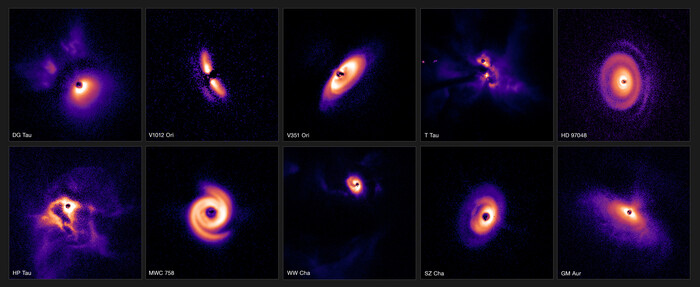The fascinating and dark secrets of the
birth of planets
are hidden around
86 young stars
, captured with extraordinary images thanks to the Very Large Telescope of the European Southern Observatory, located in Chile: this is
one of the largest investigations ever carried out on planet formation disks. planets
, which involved more than 10 countries, including Italy with the National Institute of Astrophysics of Arcetri (Florence), Catania and Padua, the University of Milan and the University of Padua.
The research provided a wealth of unique data on how planets are born in different regions of our galaxy and allowed the publication of three studies in the journal Astronomy & Astrophysics, led by Arcetri's Inaf, the Irish University of Galway and the University of Amsterdam.
To date, more than 5,000 exoplanets have been discovered, which orbit around stars other than the Sun, and are often found within systems clearly different from our Solar System.
To understand how this great variety arises, the researchers examined 86 stars in three different star-forming regions of our galaxy: those of Taurus and Chameleon, both about 600 light years from Earth, and that of Orion, which is located 1,600 light years and is known to be the birthplace of many stars more massive than the Sun. New images collected by ESO's VLT show the extraordinary diversity of disks that form around young stars and which can lead to the birth of planets .
“Some of these disks show enormous spiral arms, presumably caused by the intricate ballet of orbiting planets,” explains Christian Ginski of the University of Galway, first author of one of the studies.
“Others show rings and large cavities dug by planets in formation – adds Antonio Garufi of INAF in Arcetri, who led the second of the three searches – while still others appear extremely regular and almost dormant in the midst of all this bustle of activity”.
Astronomers were able to gather a lot of key information.
For example, analyzing the formation zone of Orion, the subject of the third study led by Per-Gunnar Valegård of the University of Amsterdam, they discovered that stars found in groups of two or more are less likely to have large formation disks planetary.
This is an important fact, because most of the stars in our galaxy, unlike the Sun, have companions.
Furthermore, the irregular appearance of the disks detected in this region suggests the possibility that there are very massive planets hidden within them.
“This is really a big step change in our field of study,” says Ginski again: “We've gone from studying single star systems to this huge overview of entire regions of star formation.”
As technology advances, researchers hope to delve even deeper into the heart of planet-forming systems.
Help in this sense could come from ESO's Extremely Large Telescope, a very large 39 meter diameter telescope under construction in Chile at 3,000 meters above sea level, which could see its first light in 2028: the ELT will, in fact, allow to study the innermost regions around young stars, where rocky Earth-like planets could form.
Reproduction reserved © Copyright ANSA

